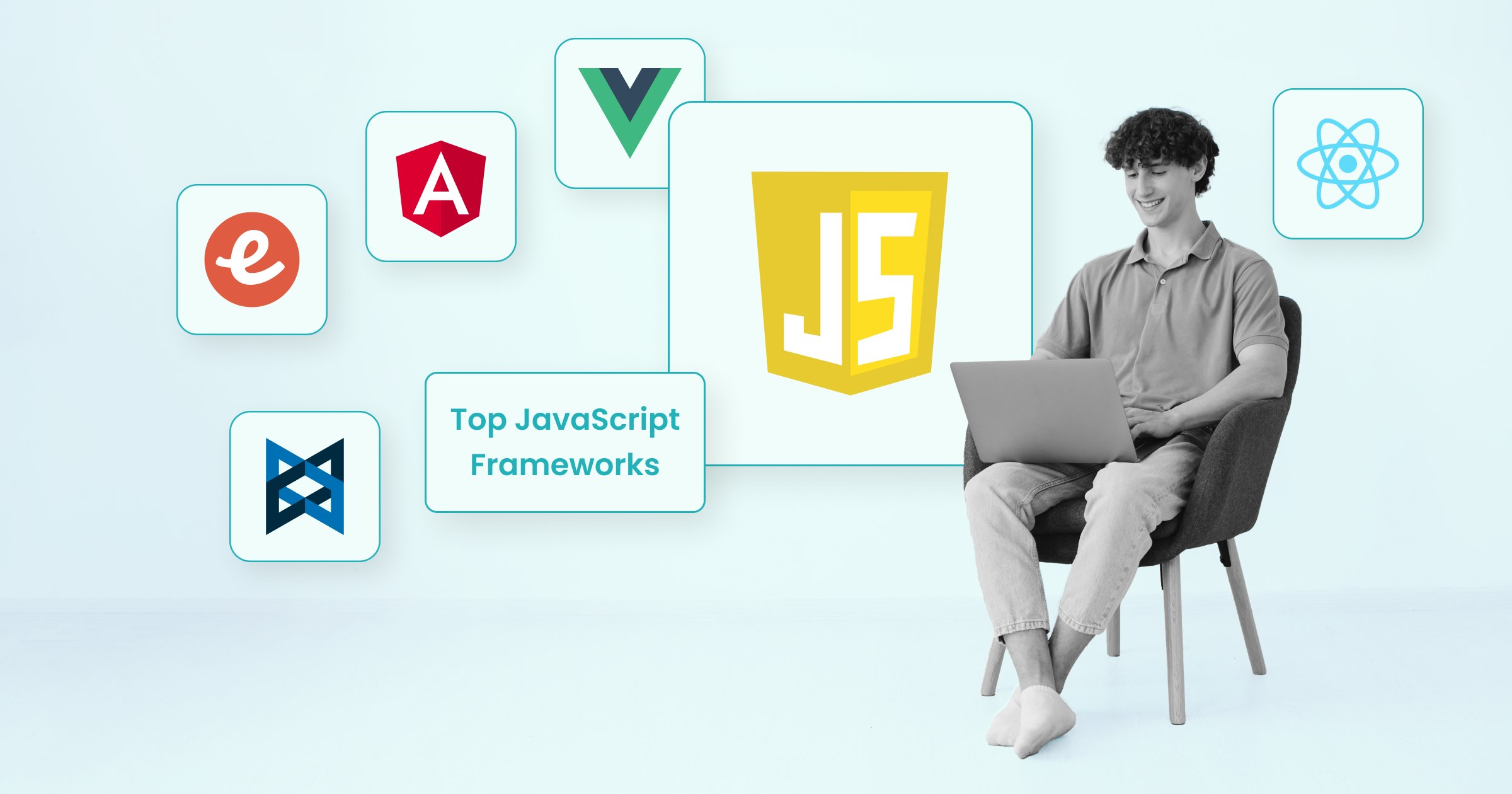Table of Content
JavaScript, as a client-side programming language, is used to run over 98.8% of websites. JavaScript’s popularity comes from its built-in features like web compatibility, versatility in working with different domains, extensive development community, and easy learning curve. Not only for front-end development, JavaScript is widely used for back-end development (65%) and mobile app development (27%).
JavaScript frameworks add convenience and accessibility to the development work. Using these frameworks, developers can reduce development time and cost. Plus, frameworks help improve the code quality and make the solution easier to scale. Modern-day businesses can benefit from these frameworks as they bring down the time-to-market, improve customization capabilities, and pave the way for building better solutions at speed. Let’s explore the best JavaScript frameworks developers use today for design and development.
A Brief Overview of JavaScript Frameworks
Frameworks dedicated to building web solutions include a set of tools, services, and resources developers can utilize to build and manage web applications and web services. In addition to assisting developers with easy web development, frameworks are also available for custom API development and application development, among others.
Within these frameworks, you will find libraries of pre-written code scripts and modules that developers or programmers use to build digital solutions. In essence, these frameworks are software in themselves as they help build, run, and manage different types of web and digital solutions.
JavaScript frameworks solve a suite of problems:
One of the most important reasons why JavaScript frameworks are used is time and cost savings. As these frameworks have pre-written code scripts, developers can extract them from the frameworks and integrate them to build full-scale digital solutions. This saves development time and costs, which businesses can harness to launch their products with speed.
5 JavaScript Frameworks Powering Business Applications and Web Solutions Development
JavaScript frameworks represent the structural foundation of digital solutions like web applications and mobile applications. As a programming language, JavaScript is built with model/view isolation and qualifies as an object-oriented programming language. These frameworks are flexible enough to make changes according to the current requirements without modifying the basic structure of the feature or design element.
Here are the top five JavaScript frameworks you must know about:
1. React
Using React, designers and developers can extract premade user interface elements and components while adding them to their solutions with minor to major changes. React is widely used to build single-page and mobile applications.
More importantly, React utilizes a virtual DOM, which makes integration with other applications easier. Hence, React is a popular choice for applications expected to have high incoming traffic.
Key Features:
React is declarative, which means it can create interactive and dynamic UI elements.
React uses JSX markup syntax, which is similar to HTML. JSX makes it easier to write code for the components in React.
The one-way data binding property makes debugging easier for complex applications.
Companies using React:
2. Angular
Angular is an open-source JavaScript framework that boasts powerful performance and efficiency in building single-page applications (SPA). However, working with Angular can also get complicated when building complex and large-scale solutions.
Google manages and maintains Angular and works on its continuous development. Angular is designed to make web development easy to control, execute, and use.
Key Features:
Angular uses the Model-View-Controller (MVC) architecture, making it an ideal framework for building dynamic web applications.
NgModules system makes Angular a modular framework, which means that all the components, services, and pipelines are built separately
Angular works directly with the DOM, leading to easier DOM manipulation, and the changes made to the codebase take effect immediately.
Companies using Angular:
3. Vue.js
Mostly used for cross-platform app development, Vue.Js is also called a progressive JavaScript framework. Vue.Js is enabled with declarative rendering and component composition, both of which are useful in building complex applications with speed. The libraries of components and services available in Vue.Js are extensible and easy to customize.
Key Features:
Vue.Js is easier to learn and use, and developers with an understanding of HTML and JS scripts can begin working with this framework.
Vue.Js has a simple architecture inclusive of capabilities like programmatic navigation, page structure, and custom layouts, and these can be updated during development.
Vue.Js templates are based on HTML, which makes it easier to handle the JavaScript framework.
Companies using Vue.js:
4. Ember.Js
Ember.Js is generally accepted as the first choice when the applications have a complex user interface. It has two-way data binding, which makes building such a UI easier.
Ember.Js was introduced as a framework to make design and development more productive and enjoyable. As a result, it provides a set of tools and services covering the entire development process.
Key Features:
Ember.Js works with the FastBoost technology for server-side rendering. This removes the need to download JavaScript assets for rendering HTML pages in the browser.
At its core, Ember.Js has CSS and HTML features, which improve the development model for web applications.
It comes with an in-built Ember Inspector debugging tool.
Companies using EmberJs:
5. Backbone.Js
Backbone.Js is another one of the JavaScript frameworks popular for building single-page applications (SPA). It comes with a Model-View-Presenter (MVP) architecture. The Backbone.Js library has seven components: models, views, collections, routers, events, sync, and options.
Key Features;
Backbone.Js has a higher adaptability aspect as it only works with JSON and standard front-end elements.
The Backbone.Js library has separate business and user interface logic components.
Companies using Backbone.Js:
How to Choose the Right Framework for Your Project?
We cannot generalize this answer as every project, development team, and business need is different. However, we recommend you follow a set of criteria to find the best JavaScript framework for your project.
1. Set Your Project Requirements And Scope
Sit down with the team and identify your requirements, which will help you define the project scope. Know why you are building an application or a website, based on which you can write down a few frameworks that can help build an impressive website or an application.
2. Find an IT Partner for Development
Once you know your requirements and project scope, find a development team for the project. Prefer working with a team with the requisite experience and expertise in using JavaScript frameworks for development. Interview the design and development team to learn about their knowledge base and then make a decision.
3. Think of the Long-Term Maintenance
While choosing an IT partner and framework, always consider the long-term requirements of the project. Will the framework you select get updated from time to time as per the existing requirements? Will the development team you choose stick with you in the future to provide additional assistance or make changes when needed? Always work with a team that can offer support and maintenance services.
4. Consider Business Scalability
Choose a framework that can help scale the website or application without putting in much work. The framework’s code scripts you choose should be readable, testable, and flexible. In the future, as businesses need to scale, they must have a JavaScript framework that makes it easier to make changes as and when needed.
5 Reasons Why You Should Use Next.JS for Your Front-End Development
Learn More5. Discuss the Budget and Licensing Costs
Discuss the budget and licensing costs of the frameworks, services, and other technologies with the chosen IT partner or development team. Set your budget first and discuss it with the internal team and IT partners.
6. Security of the App
The security of the application and web solution is paramount when choosing a framework. Choose a framework that prioritizes security and has built-in security features. Some security features you must check include SSL certification and protection against common attacks (ransomware, DDoS attacks, etc.).
7. User-Friendliness and Use Cases of the Framework
Another consideration when choosing the JavaScript framework is its user-friendliness and where it can be used most commonly. Choose a framework that makes it easier to work with and does not complicate the development process. Moreover, focus on the one with multiple use cases instead of choosing a framework suitable for only one type of digital solution.
Conclusion
JavaScript frameworks were introduced with pre-written sets of code for different services, components, modules, features, etc. Using these frameworks, designers and developers can speed up development, ensure consistency, enhance scalability, and reduce development costs. Some of the best JavaScript frameworks include React, Angular, Ember, Backbone, and Vue.
At Intuz, we have the required expertise in working with React.js and other frameworks and can deliver the solutions you need. Our understanding of all the JavaScript frameworks makes us eligible to provide bespoke solutions at your request.







